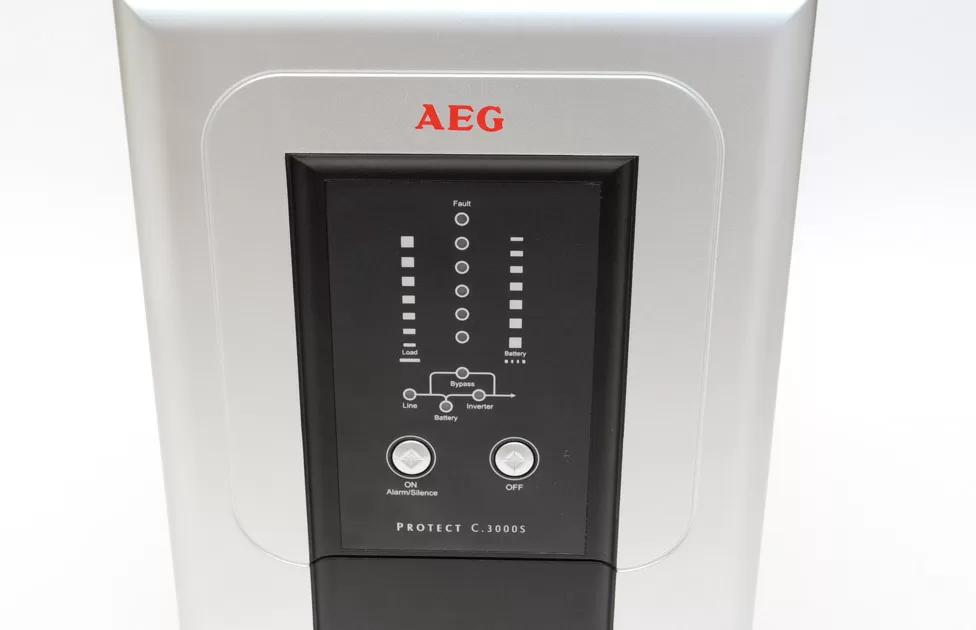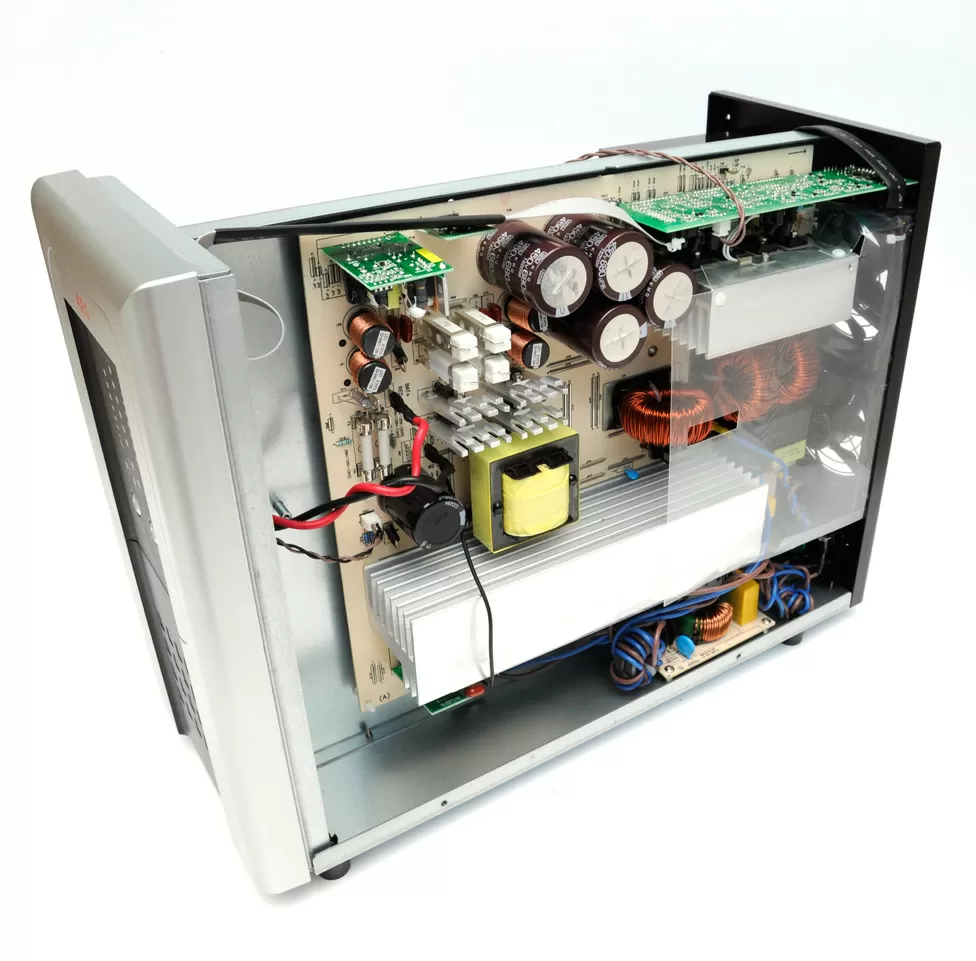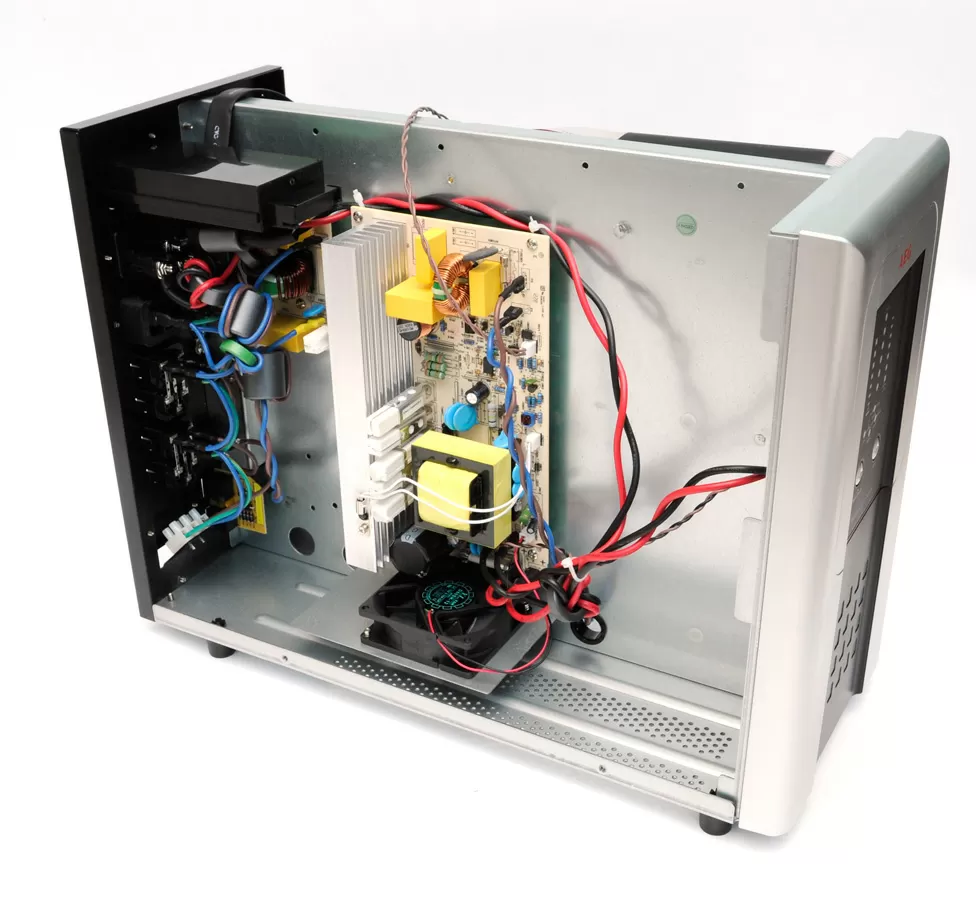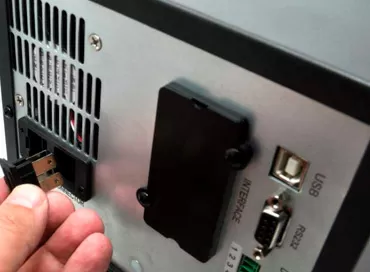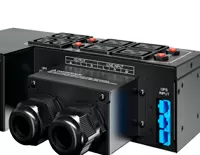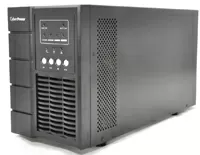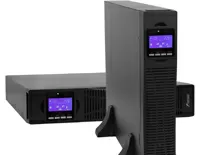AEG Protect C 3000S 3KW UPS with reinforced charger review
In the previous review of AEG UPS Uninterruptible Power Supplies for use with rack-mount equipment, we talked about the century and a half experience of AEG in the manufacture of equipment for power systems. In the coming years, this German manufacturer plans to occupy one of the leading positions in the supply of uninterruptible power supply systems on the Russian market, and what is especially important for us, it is planned to achieve this goal, including through a wide range of models. Simply put, AEG's mission is to offer every customer a UPS that meets their needs.
And today we will look at the most unusual uninterruptible power supply that we have encountered before. This is the Protect C.3000S online model with reinforced high capacity battery charger and automatic bypass. What's even more interesting is that the UPS itself does not have built-in batteries and is assembled in a free-standing case. Who might need such a model?
AEG Protect C.3000S. Get started charging!
It is known that batteries are the backbone of any UPS, which supports its autonomy. The first generations of analogue UPSs charged batteries with constant current at a fixed voltage in multiples of 12 Volts until the battery was fully charged. With a maximum charging current of 1 Ampere, the charging time for batteries can be tens of hours. Modern digital UPSs, including the AEG, can charge the battery according to a special program, performing several charging and discharging cycles, changing the charging currents in order to maximize the energy storage of the batteries. Of course, the faster the charging process takes place, the faster the batteries reach their operational readiness. In the Protect C series, AEG has an S-series UPS for loads from 1 to 10 kVA with a charging current of 4.2 A to 9.6 A. In particular, the Protect C.3000 S we tested has a charging current of up to 9.6 Amperes, while normal, without the letter S, charges the batteries with a current of up to 1 Ampere. In theory, this means almost 10 times faster battery charging, but in practice, maximum currents are required only part of the charging time, but the difference in total battery charge time is still measured in times.
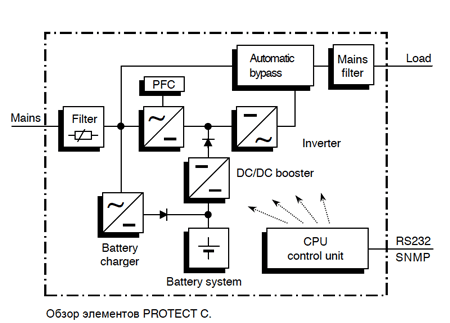
Looking at the schematic diagram of the UPS, you can see the possibility of using energy from the battery charger to supply the main load, as well as the presence of an automatic bypass that supplies power directly from the mains to the load in the event of a UPS double converter failure or its overload. By the way, in the older models Protect C.6000 and C.10000 there is also a manual bypass, which allows repair and maintenance of the UPS in a de-energized state while maintaining the power supply to the load. Interestingly, the charger works independently of the main rectifier, which means that the breakdown of the rectifier is not at all terrible for this UPS - it will be able to work in bypass mode with normal power supply and in battery mode. during power outages.
Of course, AEG Protect C.3000S is designed for use with its own battery modules, but you can use external lead-acid batteries of various capacities, and nothing prevents you from assembling a battery of the capacity you need by connecting in series and batteries in parallel. The main thing is to get the correct voltage at the battery terminals, in the case of the Protect C.3000S it is 96V. That is, you need to connect 12-Volt batteries 8 pieces in series.
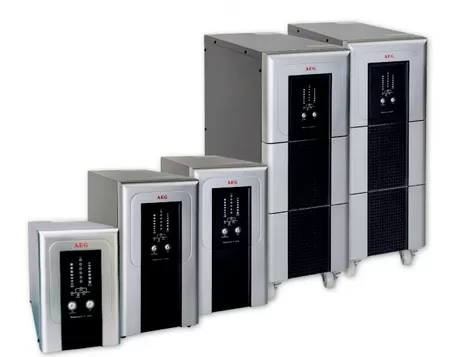
As a rule, power outages in data centers or office buildings are rare, therefore, even if the UPS batteries are completely discharged during power outages, nothing prevents you from waiting 10 or 20 hours for their complete charging - the likelihood of repeated power outages is minimal. It is another matter if we are talking about emergencies, when it is necessary to ensure the operation of equipment constantly, and electricity is provided for several hours a day. Here, intensive battery charging is an opportunity that will allow you to continue supplying the load during periods when power lines are being restored.
UPSs with increased charging current at completely autonomous facilities where renewable energy sources such as solar panels or wind generators are used are becoming even more relevant. Several hours of generator operation can provide tens of hours of equipment operation, and this is light for personnel, primary processing of the received data or communication with the outside world.
Naturally, we must not forget about the use in the private segment, for example, to maintain the energy supply of a private house. At least for security systems, emergency lighting, drain pumps or heating boiler electronics. Considering the ability to quickly charge batteries and the ability to assemble your own battery pack from 8-16 inexpensive CSB or Delta batteries, this solution looks very attractive in terms of cost and autonomy.
Up to three UPSs of the older Protect C.6000 S series can be combined in parallel, providing power to the load up to 18,000 VA, which is comparable to entering a three-room apartment, with an electric stove, or a cottage. That is, we can talk about the possibility of powering not only a good computing cluster of 140 servers, but also a small expedition camp, or a country house. Naturally, for such loads, users prefer to install rechargeable batteries with a capacity of 100-150 Ah and weighing 40-60 kg each. You can't put them in a server rack, so a stand-alone solution is the most convenient in terms of space.
Thus, we can say that AEG Protect C. 3000S is a solution for use where the UPS needs to maintain a powerful load for a long time and recharge the battery as quickly as possible after that.
Construction AEG Protect C 3000S
Externally, AEG Protect C 3000S resembles a computer in a tower format: a silver plastic front panel, a black metal case with ventilation holes - nothing special in terms of design. On the front side there is a segment indication of the load and battery charging, as well as the status of the UPS. This series does not have an LCD screen with settings control, although it would be very useful here.
All connections to AEG Protect C. 3000S are made from the reverse side, powerful 16-ampere sockets (input and 1 output IEC320 C19) are used to power the UPS itself and the load, as well as four 10-ampere sockets IEC320 C13. The UPS can protect one modem/network line through the combo RJ11/RJ45 port. Only RS-232 is provided as an interface, and if remote monitoring is required, you can purchase an SNMP card. The lack of a USB interface, frankly, does not find an excuse, and it is not entirely clear why this model has conventional IEC320 C13 sockets, without locks, like the Protect D.3000 rackmounts.
For protection against short-circuit on the input side, a 16-amp electromagnetic circuit breaker is used, on the output side - a pair of 10-amp fuses.
In the lower right corner there is a jack with “phase”, “zero” and “ground” pins for connecting the output bus. More powerful models, designed for loads of 6 KVA and 10 KVA, also have connectors for parallel connection of several UPSs and work in an N + 1 configuration. If the RS-232 port is not enough for you to communicate with the UPS through a server, you can install an SNMP card in a special slot, but now you can hardly surprise anyone.
It remains to add that the UPS electronics are cooled by two powerful 120mm fans with variable blade rotation speed. Another fan is located inside the UPS and cools that same enhanced charger with a charging current of up to 9.6 Amperes.
Let's take a look at the internal structure of the AEG Protect C.3000S. It is divided by a partition into two compartments: the inverter and rectifier on the right and the charger on the left. It is noticeable that the manufacturer was not constrained in size, therefore, between the elements of the electronics, as they say, you can stick your finger - this contributes to better cooling and allows you to judge the high tensile strength inherent in the device. All power wires inside the UPS have ferrite beads to suppress potential interference.
Inside the AEG Protect C.3000S there is a lot of free space left, apparently from the usual, "non-S" model, which has a conventional charger and built-in batteries, so you can not be afraid of overheating during prolonged work on charging batteries, even in hot weather, in poorly ventilated rooms.
There are no complaints about the quality of installation or assembly: there is a thermal sensor on each of the radiators that remove heat from the transistors. Each of the fans has a speed control, and the operation of its own monitoring system is completely invisible to the user. Electronics cares about the health of the UPS itself, and in this case, these are not empty words. The components are designed to work with a large overheating margin - over 100 degrees Celsius, which gives hope that in gentle conditions AEG Protect C.3000S will work for several years.
It's a little strange that the UPS has no relay output and no connector for an emergency power off (EPO) button.
Battery connection
The AEG Protect C.3000S series offers battery modules of different capacities. Since the battery voltage is different from model to model, the model of the modules used depends on the power of the UPS itself. So for AEG Protect C.1000 the AEG Protect C.1000 BP module is produced, for Protect C.3000 and Protect C.2000 - model C.2030BP, for the 6-thousandth and 10-thousandth - the corresponding modules are also offered. Connection is made with a 3-pin cable (plus, minus and ground).
From the side of the UPS there is no control over the originality of the connected batteries or, moreover, their chip. Therefore, most of the purchased S-versions of AEG Protect are taken initially for use with conventional lead-acid batteries for UPS. And the only difficulty that you may face is the custom plug for the battery pack. This is unlikely to result in a problem.
Testing
For testing we used 8 Yuasa NP45-12 9 Ah batteries connected in series and connected to the UPS battery connector. We were interested in the charging rate of the batteries, the discharge rate, as well as the voltage of the batteries at various stages.
Connect the AEG Protect C.3000 S to the mains and measure the consumed energy. This UPS has cooling fans that run continuously even when the unit is turned off. By the way, power consumption in off mode is quite high - 40 W , but this mode is not typical for uninterruptible power supplies.
When switched on, the UPS has its own energy consumption of 120 W , about 3.5% of the maximum connected load, and this efficiency can hardly be overestimated. However, the calculation shows that the use of a 3000 VA UPS model is advisable with a connected load already from 700 VA, and since AEG has no analogue of the S-version of lower power in the model range, you can turn a blind eye to efficiency and choose an uninterruptible power supply based on from the speed of charging the batteries. (There are models C.1000S/C.2000S/C.3000S/C.6000S/C.10000S).
The total capacity of our rechargeable batteries is 2880W (45W per cell) and the full charging time is about 2 hours. The maximum power of the UPS is required only in the first third of the charging time, in general, as it usually happens in other UPSs. It should be said that the AEG Protect C.3000 model with a conventional charger charges the built-in rechargeable batteries in more than 5 hours. That is, for such a small capacity, the difference is more than two times. When connecting external battery packs, this difference will increase.
A sharp drop in the charging current (and the power consumption of the entire system) and stabilization of the voltage at the battery terminals in the 50th minute indicates that the batteries are 90% charged. Listen to these figures - 50 minutes to charge 8 batteries of 9 Ah each! Let's look at the rank!
The connected 400 W load has depleted the batteries within 56 minutes. The low battery alarm in the form of a sound signal was triggered exactly 5 minutes before the load was completely disconnected, which is enough to turn off any server. All this time, the voltage at the output of the UPS was 230 Volts, and only small deviations of 1 Volt can be attributed to the measurement error.
An interesting picture is obtained - when working with a load of 400 VA, the AEG Protect C.3000S uninterruptible power supply with our conventional batteries shows 100% efficiency of time: it is completely discharged and fully charged in the same amount of time! And if the power outage was brief, the UPS will recharge even faster.
Warranty
AEG uninterruptible power supplies are covered by a 3-year warranty (2 years of basic warranty + 1 year with free registration on the manufacturer's website). We recommend that you definitely use product registration when purchasing. There are no expansion packs or warranty extensions for this product yet.
Conclusions
The advantages of the device are clear, but the disadvantages of the AEG Protect C.3000S, I would attribute its extreme lack of communication. The built-in display panel looks confusing. And although you can always see the UPS operating mode, it will not be easy to understand its utilization and battery charge level. By itself, AEG Protect C.3000S will not signal the generator to turn on, and you will have to additionally install a relay harness at the input and output (including for emergency shutdown). The manufacturer's refusal to use the USB interface looks like just an unjustified mistake - you can't approach it with a laptop.
Considering the characteristics of the UPS as a whole, I would like to touch upon the issue of its integration at sites. Most electronic systems today use backup power circuits of varying capacities. And if in data centers and data centers these are servers and switches, then in commercial facilities it is lighting and access and video surveillance systems. Somewhere there is the possibility of installing and starting generators, and somewhere autonomy is achieved only through the accumulation of energy in batteries. With the introduction of the AEG Protect C.3000S, security companies have gained some flexibility in the configuration of their backup power system. Yes, you can use the accumulation of energy in batteries where it was previously impossible due to the short charging time. For example, in the already mentioned alternative energy sources. In an hour, you will save many times more energy than in conventional UPSs, and this feature can reduce the cost of backing up a project at times! You will be able to use cheap lead-acid AGM batteries of large capacity, now you can store energy during the day and give it off at night, or, conversely, in systems where there is a periodic energy shortage. And do not forget that throughout the entire operating time, the load connected to the AEG Protect C.3000S will be protected by the most advanced double conversion method available today. Regardless of the battery charge, the output will always be 230 volts and a flat sine wave.
AEG Protect C.3000S turned out to be more interesting not as a device, even the most modern one, but as a tool that will help save on backup power supply, and which can be used even by non-experts in electrical engineering.
Mikhail Degtyarev (aka LIKE OFF)
11/21/2013


